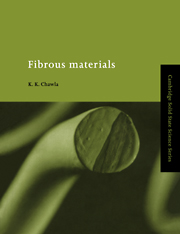Book contents
- Frontmatter
- Contents
- Preface
- Acknowledgments
- Chapter 1 Introduction
- Chapter 2 Fibers and fiber products
- Chapter 3 Natural polymeric fibers
- Chapter 4 Synthetic polymeric fibers
- Chapter 5 Metallic fibers
- Chapter 6 Ceramic fibers
- Chapter 7 Glass fibers
- Chapter 8 Carbon fibers
- Chapter 9 Experimental determination of fiber properties
- Chapter 10 Statistical treatment of fiber strength
- References
- Suggested further reading
- Appendix A Some important units and conversion factors
- Author index
- Subject index
Chapter 8 - Carbon fibers
Published online by Cambridge University Press: 13 October 2009
- Frontmatter
- Contents
- Preface
- Acknowledgments
- Chapter 1 Introduction
- Chapter 2 Fibers and fiber products
- Chapter 3 Natural polymeric fibers
- Chapter 4 Synthetic polymeric fibers
- Chapter 5 Metallic fibers
- Chapter 6 Ceramic fibers
- Chapter 7 Glass fibers
- Chapter 8 Carbon fibers
- Chapter 9 Experimental determination of fiber properties
- Chapter 10 Statistical treatment of fiber strength
- References
- Suggested further reading
- Appendix A Some important units and conversion factors
- Author index
- Subject index
Summary
Carbon fibers have become established engineering materials. In view of their commercial importance, we devote a separate chapter to them. Carbon is a very versatile element. It is very light, with a theoretical density of 2.27 gcm–3. It can exist in a variety of forms, glassy or amorphous carbon, graphite, and diamond. Carbon in all these forms can be found in nature. Carbon in the graphitic form has a hexagonal structure and is highly anisotropic. The diamond form of carbon has a covalent structure and is an extremely hard material. The latest addition to the variety of forms of carbon is the Buckminster Fullerene, or the Buckyball with a molecular composition such as C60 or C70. In this chapter, we follow the same sequence as in previous chapters; processing, structure, properties and applications of carbon fibers. However, in order to understand these aspects of carbon fiber, it is helpful to review the basic structure and properties of graphite.
Structure and properties of graphite
Carbon fiber is a generic name representing a family of fibers. Over the years, it has become one of the most important reinforcement fibers in many different types of composites, especially in polymer matrix composites. It is an unfortunate fact that the terms carbon and graphite are used interchangeably in commercial practice as well as in some scientific literature. Rigorously speaking, graphite fiber is a form of carbon fiber that is obtained when we heat the carbon fiber to a temperature greater than 2400°C.
- Type
- Chapter
- Information
- Fibrous Materials , pp. 211 - 233Publisher: Cambridge University PressPrint publication year: 1998



